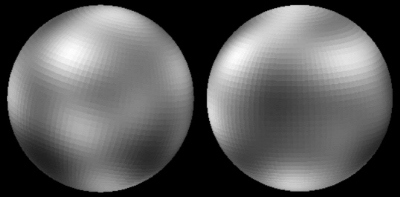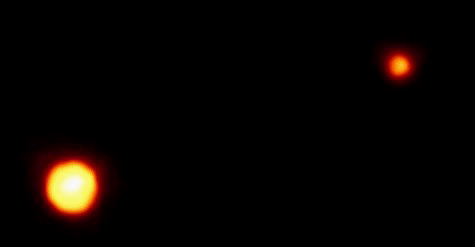
Pluto, A Dark, Frozen World
These pictures of Pluto, taken by the powerful Hubble Space Telescope, gives just a hint of what Pluto may look like. The squares in the pictures are a result of the image being enlarged so much.

Pluto and Its Moon Charon
The Hubble Space Telescope was able to take this picture of Pluto and Charon. Even with the aid of powerful computers here on Earth, all we get is a hint of what the tiny planet and its moon are really like.
Pluto is the ninth, or last, planet in the solar system. The orbit, or path the planet takes around our Sun is an ellipse. For this reason there are times when Pluto is the furthest away from the Sun. There are also times when it is closer to the Sun than Neptune. Pluto's average distance from the Sun is over 3.5 billion (3,500,000,000) miles. The closest Pluto gets to the Sun is over 2.7 billion (2,700,000,000) miles, and the furthest away it gets is over 4.5 billion (4,500,000,000) miles. From Pluto, the Sun is not much brighter than any other star. If you could look at our solar system from an "edge", most of the planets would be on a line like a table top, with the Sun being in the middle. This line, also called a plane, is the ecliptic, and the rest of the planets' orbits stay on this line. Pluto's orbit is tilted at an angle to the rest of the solar system. A year on Pluto lasts for 248 Earth years! It takes over six Earth days to to equal one day on Pluto. Pluto is also one of the planets that spins in the opposite direction from Earth.
Pluto is so tiny, and so far away, that you will need a telescope that is at least ten inches in diameter. You will also need to know exactly where to look for it. If there is an observatory close to where you live, you might be able to see it through their telescope. Even if you can find the planet, it will be nothing more than a pinpoint of light among the stars.
Pluto is the smallest planet in our solar system at a little over 1,300 miles in diameter, or about one-sixth the diameter of Earth. Put another way, if Earth was the size of a basketball, Pluto would be the size of a ping-pong ball. Many of the moons of other planets, including our very own Moon, are larger than Pluto.
Pluto has one tiny moon, named Charon, that wasn't discovered until 1978. Charon is half the size of Pluto. No other moon in the solar system is as large, when compared to its mother planet, as Charon. Pluto and Charon are so similar in size that some astronomers think of them as a double planet.
Pluto was discovered in 1930 by astronomer Clyde Tombaugh. After Neptune was discovered, astronomers noticed that something was changing the orbits of Uranus and Neptune and decided that there must be another undiscovered planet that was causing these changes. Mr. Tombaugh spent a long time taking photographs of the area of the sky where the unknown planet should be and finally discovered Pluto in one of the photographs. Pluto is the Roman god of darkness and the underworld. Perhaps Pluto got its name because it is always in darkness. It may have also gotten its name from the fact that its symbol "PL" are the initials of Percival Lowell, who founded the observatory where Mr. Tombaugh worked.
Pluto is the only planet in our solar system that we have not explored with a spacecraft. What we know about the dark, frozen world is the result of many years of work by dedicated scientists here on Earth. The current studies tell us that Pluto is made up of a mixture of rocks and several kinds of "ices". Scientists believe that most of the ices that make up Pluto are frozen methane and ammonia.
Since the planet is so far away from the Sun, it gets almost no light or heat. Scientists believe that the temperature on the surface of the ninth planet is over four hundred degrees Fahrenheit below zero. At this low temperature, almost everything freezes solid. Scientists here on Earth have determined that Pluto does have a very thin atmosphere, but it is far too thin to support any kind of life.
Back To Main Menu
Use the "BACK" button on your Browser to return to the previous page.